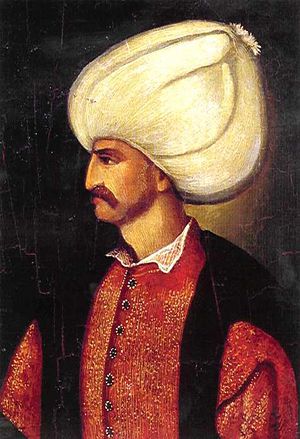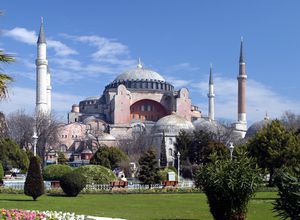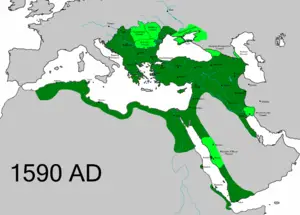Difference between revisions of "How Did the Ottoman Empire Become the Third Great Islamic Caliphate"
| Line 33: | Line 33: | ||
===References=== | ===References=== | ||
| + | {{Contributors}} | ||
Revision as of 04:21, 9 April 2018
Shortly after the death of Muhammad in 632, his followers divided themselves into factions that sought control over the community of believers of what would become known as Islam. Early Islamic thinkers and leaders believed that under the new religion, the “church” and state should be combined in one government hierarchy, known as a caliphate, and ruled by a single autocratic ruler or caliph. Throughout early Islamic history many despots claimed the status of caliph, but few the early dynasties that claimed to be the caliphate fit the criteria of having the majority of the Muslims under its rule and by having control of the holy cities of Mecca and Medina. Scholars generally consider the Umayyad and Abbasid dynasties to be the first two caliphates, with the Ottoman Empire being the third great Islamic caliphate.
Although the Ottoman rulers usually referred to themselves as sultans instead of caliphs, the Ottoman Empire fit the definition of a true Islamic caliphate: at its height, most of the Islamic world, including the holy cities, were under its rule. A number of factors contributed to the Ottoman Empire becoming the third great Islamic caliphate, which included some traits the Ottomans brought with them to Anatolia and others they developed once they were established. The nomadic nature of the Turks was one of the primary factors that helped the Ottomans defeat their more sedentary and civilized enemies. Once they established a foothold in Anatolia, the Ottoman Turks were willing to accept ideas from all types of people and employed many of these peoples, even non-Muslims, in their government.
Contents
The Concept of the Caliphate
After the death of Muhammad, his followers believed that there should be a temporal leader who enforced the teachings of the Quran and Hadith among the community of believers. Abu Baker, Umar, and Uthman were the first three caliphs during the early decades of Islam. In very short order, Islamic armies emerged from the deserts of the Arabian Peninsula and took the Levant from the Byzantine Empire in 636 and then defeated the Sassanid Persians in 637 at al-Qadisiyah, which opened Iraq and Persia to Islamic expansion. The next major country to fall was Egypt in 642 and the rest of North Africa soon followed. Despite the initial military successes of Islam, there were many rival factions within the religion, which ultimately resulted in Uthman’s assassination in 656. The assassination of Uthman proved to be the spark that ignited the First Civil War (656-661), plunging the Islamic world into a bloody sectarian conflict between the Sunni and Shia branches of the new religion. [1]
When the dust of the First Civil War finally settled, The Umayyad Dynasty controlled virtually all of the Islamic world, which at that time stretched from Spain to Persia. For nearly 100 years the Umayyads provided leadership for the Islamic world, but as the ranks of Islam grew, so too did the number of different ethnicities that followed the religion. By the middle of the eight century, non-Arabs began to resent the almost total control that the Arabs wielded in the Umayyad Dynasty, which included most of the important administrative positions. In 750 the Umayyad Dynasty was overthrown and replaced by the Abbasid Caliphate, which was based in the city of Baghdad, far from Arabia or even the Umayyad capital city of Damascus. [2] The Abbasids ushered in a period of Islamic history that is often referred to by modern scholars as the “Golden Age of Islam,” where art, science, and literature, often written in Persian, were promoted by the caliphs. The second great Islamic caliphate truly had a more Persian influence and although theologically in line with the Sunni branch of Islam, it was much more tolerant of Shia Islam. [3] By the late eleventh century, though, the Abbasid caliphate was effectively challenged by other Islamic dynasties, such as the Fatimid Dynasty in Egypt and the Seljuk Turks. To make matters worse for the Abbasids, the beginning of the Crusades in the late eleventh century brought large European armies into the Middle East, which further challenged Islamic authority. The final blow to the Abbasid caliphate came when the Mongols invaded the region and executed the last Abbasid caliph in 1258. The Mongols followed that act up by sacking Damascus in 1260, sending most of the Islamic world into a protracted state of turmoil. [4] It would be nearly 100 years before another Islamic dynasty could accurately claim the title of caliphate.
Early Ottoman History
The manner in which the Ottomans evolved from a minor nomadic Turkish tribe to being the masters of the Islamic world is truly remarkable. The Ottoman Dynasty was named for its founder Osman I (ruled 1299-1324), who led his band of Turks to conquer most of eastern Anatolia (modern day Turkey) in relatively short order. His successors followed up his battlefield conquests by taking western Anatolia in 1326, Greece in 1345, and Serbia in 1389 at the Battle of Kosovo. [5]
Mehmed II (ruled 1444-1446 and 1451-1481), often known as Mehmed “the Conqueror,” ushered in the era of the Ottoman Empire’s greatest age. Although Mehmed II used the royal title of “sultan,” he was the first Ottoman ruler to see himself as a caliph because he conquered most of the Islamic world, including the holy cities. In 1453 Mehmed II conquered Constantinople and ended the Byzantine Empire, which essentially eliminated any major rivals in the region. Mehmed II’s successors conquered the Balkans and other kingdoms in southeast Europe in the early sixteenth century before turning their eyes back toward the Islamic world. Suleiman I (ruled 1520-1566), also known as Suleiman “the Magnificent,” conquered Algiers in 1529 and besieged but failed to take Vienna that same year. By the late fifteenth century the entire Islamic world west of Persia was under Ottoman control, which included Medina and Mecca. [6]
Mehmed II may have ruled in a style that was modeled on the earlier caliphs, but Suleiman I was the first Ottoman sultan to call himself “caliph of the world.” From Sulieman I’s rule onward, the Ottoman sultans ruled over most of the world’s Muslim population and controlled Mecca and Medina, making the Ottoman Dynasty the third true Islamic caliphate.
Tactics and Ideas that Made the Ottoman Empire the Third Caliphate
Probably the most important factor that led to Ottomans’ dominance in the Islamic world was their martial background and ideology. Before they ruled a vast empire, the Ottomans were nomadic warriors who were more at home on the steppes than they were in cities and leading the charges in their battles were fighters known as ghazis. Essentially, ghazis were Turkish warriors who fought on the fringes of the Islamic world against all outsiders, both non-Muslim and Muslim. The wars that the ghazis waged on the outsiders were known as ghaza, which was similar to the Islamic holy war known as jihad. For the Ottoman Turks, though, ghaza proved to be a much more flexible form of holy war that allowed them to expand their realm at the expense of non-Muslim and Muslim neighbors alike. Ghaza was not confined by the narrow legalism of jihad, which prohibited Muslims from waging holy war against other Muslims and also proscribed Muslims from aligning with non-Muslims against Muslims. Ottoman ghazis were free to attack anyone and align with anyone as long as it benefitted the Ottoman state, which ultimately allowed the Ottomans to expand their realm and create the caliphate in a way that would have been impossible at the time under the rules of jihad. [7]
As the Ottomans waged war on Muslims and non-Muslims alike, they made sure that holy men were part of the vanguard along with the ghazis. Islamic holy men, known as Sufis, brought infrastructure to the territories that the ghazis conquered and converted non-Muslims to Islam in the process. Although the Sufis were primarily men of learning, they were often also trained to fight alongside the ghazis if needed. [8]
Finally, where the ghazis and Sufis pushed the boundaries of the Ottoman state farther through conquest, slave soldiers were able to keep the state strong. The Ottomans introduced a tax system whereby they took a certain number of young boys from their Christian subjects, especially in the Balkans region, to serve as slave soldiers. These slave soldiers were known as janissaries and despite their status, they were often among the elite soldiers in the Ottoman army. Christian boys who were taken to be janissaries were raised as Muslims and taught Arabic and Turkish so that they could read the proper religious and political texts. Most importantly, the janissaries were trained in the use of gunpowder and became some of the first military units in world history to effectively employ small firearms on the field of battle. [9]
Another major factor that contributed to the Ottoman Empire becoming the caliphate was its openness to the West. Although the Ottomans conquered many kingdoms in Europe, they were not dedicated to constant jihad against the Christian world the way the Umayyad caliphate was. The Ottomans invited European scholars to their court and non-Turks eventually came to comprise a majority of their bureaucrats. The Ottoman Empire’s geographic location as a halfway point between the Western and Eastern worlds also proved to be quite economically beneficial to the Ottoman rulers who constantly needed funds to keep their ever growing bureaucracy running. Similar to their other policies, the Ottomans were willing to trade with any people, Muslim or non-Muslim. [10]
Finally, the Ottomans were also the recipients of a fair amount of historical luck that enabled them to rule the Islamic world. When the Ottomans came to power, the Islamic world was in shambles and although the Persian Safavid Dynasty was strong, it was not powerful enough to unite the majority of the Islamic world. The Ottomans were able to take advantage of the political situation by using their strong armies to quickly dispatch any resistance that the other Muslim kingdoms offered.
Conclusion
The Ottoman Empire is known today for being one of the greatest empires of the modern world, but it was perhaps more important for being the third great Islamic caliphate. The Ottomans were able to accomplish this feat through their military ideology and policies, their openness to work with Christians and the West, and the fact that there were no other viable Islamic dynasties that could reasonably challenge to become the caliphate. Ironically, some of the policies that made the Ottoman Empire the premier Islamic dynasty in the Late Medieval and Early Modern historical periods are the same factors that led to its decline in the early seventeenth century.
References
Admin, Jaredkrebsbach and EricLambrecht- ↑ Donner, Fred M. “Muhammad and the Caliphate.” In The Oxford History of Islam. Edited by John L. Esposito. (Oxford: Oxford University Press, 1999), pgs. 15-16
- ↑ Donner, p. 20
- ↑ Donner, pgs. 31-32
- ↑ Denley, Peter. “The Mediterranean in the Age of the Renaissance, 1200-1500.” In The Oxford History of Medieval Europe. Edited by George Holmes. (Oxford: Oxford University Press, 2001), p. 245
- ↑ Denley, p. 251
- ↑ Lapidus, Ira M. “Sultunates and Gunpowder Empires.” In The Oxford History of Islam. Edited by John L. Esposito. (Oxford: Oxford University Press, 1999), p. 374
- ↑ Darling, Linda T. “Contested Territory: Ottoman Holy War in Comparative Context.” Studia Islamica. 91 (2000) p. 137
- ↑ Lapidus, pgs. 372-3
- ↑ Lapidus, p. 377
- ↑ Lapidus, pgs. 388-40


